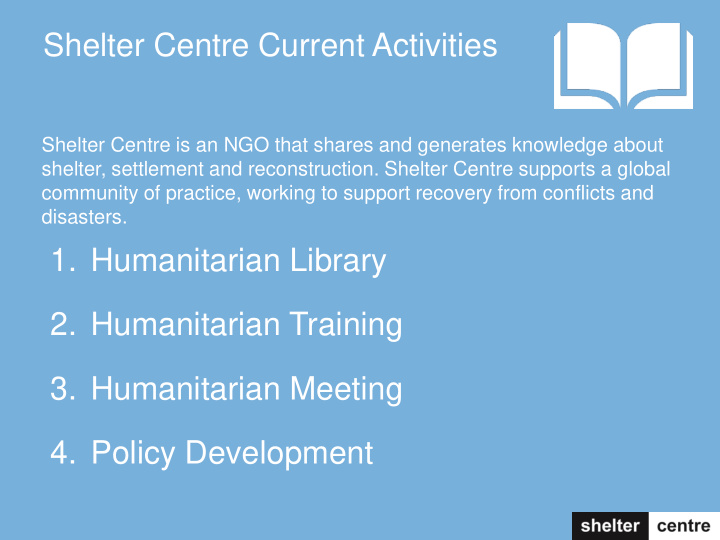



Shelter Centre Current Activities Shelter Centre is an NGO that shares and generates knowledge about shelter, settlement and reconstruction. Shelter Centre supports a global community of practice, working to support recovery from conflicts and disasters. 1. Humanitarian Library 2. Humanitarian Training 3. Humanitarian Meeting 4. Policy Development
1. Library Problem Statement - Locating this document if you do not know its exact title - Challenges in locating and sharing local documents - General knowledge is spread over thousands of websites - Moderation often reflects the priorities of library managers rather than users - Moderation is costly to administer and slows uploading
1. Library Current Activity – Shelter & Settlement Library - Development of Shelter & Settlement Library, building on Shelter Centre’s current Shelter Library - Current Library contains 1457 documents from more than 250 organisations - Shelter & Settlement Library will: • Contain at least an additional 900 documents • Showcase improved functionalities, innovative approach to crowd sourcing and user moderation
1. Library Future Plans – Humanitarian Library - Development of the Shelter & Settlement Library will allow us to build strong foundations for the Humanitarian Library. - User-upload approach: Local and regional knowledge is directly uploaded in native languages - Community moderation: Users will be able to upload, rate resources and create and share booklists - Will support cross-sector knowledge management and sharing - Open-source software for global sharing and integration
2. Training Problem Statement – 80-90% of people working in disaster responses have little or no prior experience and little or no training – The cost of delivery of conventional humanitarian training to the required number of people is unaffordable and prohibitive – Most humanitarian training only has content available in Western languages – In house agency-specific training programmes lack commonly agreed standards
2. Training Current Activity – CORE Training – Training of Trainers (ToT) and Workshops Training – Naturally sustainable and scalable structure – Designed to build on and enhance existing in-country training capacity through open source training material, TOT's and a franchise based delivery model – Cost-effective, adjustable to specific audiences and delivered in local languages – Delivers key messages of 5 IASC Clusters and cross-sector standard training
2. Training Scalable and Sustainable System – Scalability achieved through sustainable training capacity – Each trainer trained through ToT can conduct CORE Workshops – Highly skilled participants can become Core Trainers – Up-scaling allows high-quality training and sustainable system
2.Training Future Plans – Continuing the cascade effect of CORE scalable structure to reach the 80-90% of people working in disaster responses have little or no prior experience and little or no training – In 2013, to deliver at least 3 TOT and workshop programmes, provisionally in Indonesia, Myanmar & Timor – Expand delivery to key messages of the 11 IASC Clusters
3. Meeting Problem Statement Limited access to open forums to: – Build consensus between the wide range of humanitarian actors – Share good practice and lessons learned – Involve the wider community in projects and developments
3. Meeting Current Activity – Shelter Meeting - Consultation: Inform, agree and prioritise new projects - Review: testing and assessing of existing projects and strategies - Consensus: Generating agreement on policy and operating procedures - Publications: Launching authoritative and collaborative publications - In the last 5 years only, more - Knowledge Management: sharing project activities, than 1000 attendees from 200 programmatic and technical good organisations practice
3. Meeting Future Plans – Humanitarian Meeting Problem: Initiatives out of Clusters’ work - plans are currently not recognised - Problem: No common space for the review and dissemination of innovations or projects worldwide - Solution: Humanitarian Meeting will combine strategic and technical dimensions of humanitarian work - Solution: Act as a global incubator for innovation within the humanitarian sector - Solution: Hosted on a website that allows humanitarian stakeholders worldwide to share, follow, review and disseminate projects
4. Policy Development Problem Statement Existing guidelines are often developed without sector consultation to: – Build consensus – Develop commonly owned guidelines – Analyse and integrate good practice and lessons learned – Expand use of final documents to multilateral, regional and local humanitarian actors
4. Policy Development Current Activity SC’s approach to Policy Development: – Brings together specialist expertise – Acts upon collaborative efforts with humanitarian actors – Produces authoritative policy and technical guidance documents – Generates consensus and good practices – Focuses on operational activities and organisations
4. Policy Development Future Plans – Consult on and develop Cluster Approach Guidelines – Explore other opportunities to tackle humanitarian sector problems – Continue to develop a collaborative approach to policy development
Recommend
More recommend